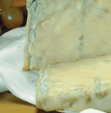Gift wrapped Cheeses with a Walnut Sauce

This recipe is finds its origins in necessity. Cheese is one of the primary nutrients in Piemonte culture. Families would protect their cheese as they would protect their animals. These elements were survival. Thus, every family had cheese. Various types and sometimes the remaining pieces, by themselves, could not be used. Agnolotti are one of the preferred forms of filled fresh pasta. They had cheese. Mix the cheeses together, add some bread crumbs and an egg, roll into your favorite pasta shape. Serve with butter and Sage. A marvelous meal is served. The tastes and flavors are what everyone loves, they know the individual ingredients but the combination is unique, so much so, that your family looks forward to this work of art that is, in reality, leftovers.
This is how Raffaella’s recipe came to be. We love fresh pasta like tortellini, agnolotti, ravioli and others but the holidays are here. Why not make pasta in the form of a wrapped gift? Butter and sage is a nice finish to just about any pasta dish but we like somewhat more elaborate combinations of flavors. Raffaella has perfected her Walnut white sauce over the years and seemed an appropriate choice. We drank this with a Pinot Grigio from Friuli, an Arneis would also be a great compliment.
Recipe for 6 people
Ingredients for Caramelle
21 oz (600 g) Fresh Pasta
7 oz. (200 g) Shredded Fontina
7 oz. (200 g) Ricotta
7 oz. (200 g) Shredded Mozzarella
3 ½ oz. (100 g) Parmesan Cheese
3 Egg yolks
2 oz (60 g) Chopped Italian Parsley
Ground Nutmeg
Freshly ground Black Pepper
Salt
Ingredients for Walnut Sauce
7 oz (200 g) Shelled walnuts
2 oz (60 g) Grated Parmesan Cheese
7 oz (200 ml) Heavy Cream
A Touch of Chopped Italian Parsley
Preparation Filling:
In a large mixing bowl add the cheeses, the egg yolks, chopped parsley, ground nutmeg, salt and pepper to taste.
With your hands, work the mixture until the cheeses are well combined and the egg yolks are completely absorbed. The mixture will be dense but pliable. Since you will probably switch cheeses according to what is in your refrigerator, the consistency should be very dense but not crumbling. If the mixture is too dense, add 1 tbsp of heavy cream at a time, mixing well.
 Preparing the Wrapped Gifts
Preparing the Wrapped GiftsCut the pasta into 3” x 4” rectangles (even if they are not perfectly 3x4 that’s ok). Place the filling in the center leaving about ½ inch on the long ends and about 1 inch on the short ends. Wrap the short sides as you would a package, sealing the pasta with a bit of water between the two folds, if necessary. Finally, press the long ends closed and gently rotate the pasta pinching the past close to the filling.
 Preparation Walnut sauce
Preparation Walnut sauceFinely chop the walnuts. In a medium sized mixing bowl, add the chopped nuts, Parmesan and heavy cream. Mix well.
Cook the pasta in abundant salted hot water for 6 minutes.
Remove the pasta from the water with allow the pasta to drain completely.
 While straining the pasta add pasta water to the sauce, 1 tbsp at a time, until the sauce has the desired consistency.
While straining the pasta add pasta water to the sauce, 1 tbsp at a time, until the sauce has the desired consistency.Mix the sauce over the hot pasta and sprinkle with chopped parsley. Always serve pasta hot!
Tags: Gourmet Foods Pasta Italian Cheese Holiday Traditions Italian Holidays Italian Recipes Food and Wine Travel Italy
Labels: Gourmet Foods, Italian Cheese, Italian Recipes, Pasta, walnuts


















 Turin is the regional seat of Piemonte. The Olympics in Turin actually spread out over the entire region. When thinking about Piemonte the things that come to mind are skiing, grissini, tartufo di Alba, cheese and of course wine. Today’s subject is cheese!
Turin is the regional seat of Piemonte. The Olympics in Turin actually spread out over the entire region. When thinking about Piemonte the things that come to mind are skiing, grissini, tartufo di Alba, cheese and of course wine. Today’s subject is cheese!



